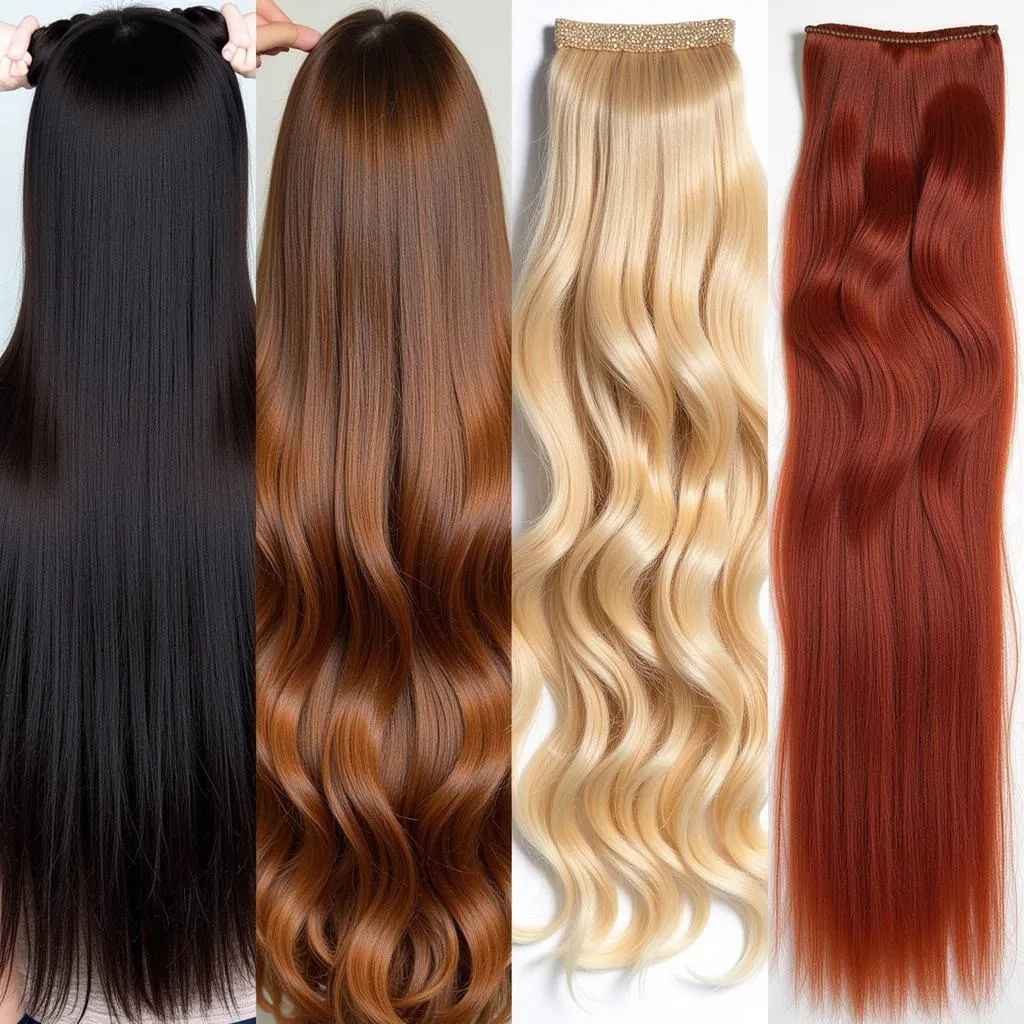Natural hair colors encompass a spectrum of shades determined by the concentration and ratio of pigments produced by cells called melanocytes within hair follicles. While black and brown reign supreme as the most prevalent hair colors globally, variations like blonde, red, and shades in between paint a vibrant tapestry of human diversity.
Deciphering the Science of Hair Pigmentation
Melanin, the pigment responsible for bestowing color upon our hair, exists in two primary forms: eumelanin and pheomelanin. Eumelanin governs black and brown hues, with higher concentrations yielding darker shades. Conversely, pheomelanin manifests as red and yellow tones, contributing to strawberry blonde, auburn, and fiery red hair colors.
The interplay between these two melanin types determines an individual’s unique hair color. For instance:
- Black hair: Abundant eumelanin, minimal pheomelanin.
- Brown hair: Moderate levels of both eumelanin and pheomelanin.
- Blonde hair: Low eumelanin, varying amounts of pheomelanin.
- Red hair: Predominantly pheomelanin with low eumelanin.
 Hair Follicles and Melanin Types
Hair Follicles and Melanin Types
Interestingly, the shape and distribution of melanin granules within the hair shaft also influence color perception.
Exploring the Spectrum of Natural Hair Colors
While countless subtle variations exist, we can broadly categorize natural hair colors into the following:
- Black: The most prevalent hair color worldwide, black hair ranges from jet black to softer black with subtle brown undertones.
- Brown: This category encompasses a vast spectrum, from dark chocolate brown to light brown with hints of gold.
- Blonde: Characterized by low eumelanin, blonde hair can span shades of platinum, golden, strawberry, and ash blonde.
- Red: With its fiery hues, red hair owes its vibrancy to pheomelanin. It ranges from deep auburn to bright copper and strawberry blonde.
 Natural Hair Color Swatches
Natural Hair Color Swatches
Factors Influencing Natural Hair Color
Several factors intertwine to determine an individual’s natural hair color, including:
- Genetics: Genes inherited from parents dictate the types and amounts of melanin produced by hair follicles.
- Ethnicity: Certain ethnicities tend to exhibit specific hair color patterns due to shared genetic ancestry.
- Age: Hair color can change over time, often darkening in childhood and lightening or graying with age.
- Environmental factors: Sun exposure, for instance, can lighten hair color, while certain medications might influence pigmentation.
“Hair color is a fascinating interplay between genetics, pigment production, and even environmental factors,” explains Dr. Emily Carter, a leading dermatologist specializing in hair and scalp health. “Understanding these influences provides a greater appreciation for the beautiful diversity of natural hair colors.”
Embracing and Enhancing Your Natural Hue
Whether you boast raven black locks or sun-kissed blonde strands, embracing your natural hair color is key to feeling confident and radiant. However, if you’re yearning for a change, countless options exist to enhance or temporarily alter your natural hue.
For those seeking subtle enhancements:
- Hair gloss: This treatment adds shine and can subtly deepen or enhance your natural color.
- Toner: Used to neutralize unwanted brassiness or yellow tones, particularly in blonde or lightened hair.
For more dramatic transformations:
- Hair dye: Permanent or semi-permanent dyes offer a wide array of colors to choose from. For a less permanent option, explore what color toner to use on orange hair.
- Highlights or lowlights: Strategically placed lighter or darker strands can create dimension and visual interest while complementing your natural base color. Consider how to part hair for peekaboo color for a bold and trendy look.
When experimenting with hair color, it’s crucial to:
- Choose products suited for your hair type and condition.
- Seek professional guidance, especially for significant color changes or if you have concerns about hair health.
- Maintain hair health with regular conditioning treatments and minimize heat styling to prevent damage.
Conclusion
Natural hair colors result from a complex interplay of genetics, pigment production, and environmental influences. From the richness of black and brown to the vibrancy of blonde and red, these hues contribute to the beautiful tapestry of human diversity. Understanding the science behind hair pigmentation allows us to appreciate our natural colors while exploring ways to enhance or transform them safely and effectively.
FAQs
1. Can hair color change naturally over time?
Yes, hair color can change naturally throughout life due to factors like aging, hormonal fluctuations, and environmental exposure.
2. What causes premature graying of hair?
Genetics, stress, nutritional deficiencies, and certain medical conditions can contribute to premature graying.
3. Is it possible to permanently change my natural hair color?
Yes, permanent hair dyes penetrate the hair shaft, altering the color permanently until new hair grows.
4. Are there natural ways to enhance hair color?
Certain herbs like henna and chamomile can subtly enhance or tint hair color, but results are temporary and subtle.
5. How can I prevent hair color from fading?
Using color-safe shampoos and conditioners, minimizing sun exposure, and limiting heat styling can help preserve hair color vibrancy.
Do you have other questions about hair color? Here are some resources you might find helpful:
- What color do yellow and brown make?
- How to remove blue hair color?
- What colors do brunettes look good in?
For personalized advice and expert assistance with achieving your desired hair color, don’t hesitate to contact us. Call us at 0373298888, email us at [email protected], or visit our salon at 86 Cầu Giấy, Hà Nội. Our dedicated team is available 24/7 to provide top-notch service and help you unlock the full potential of your hair.

